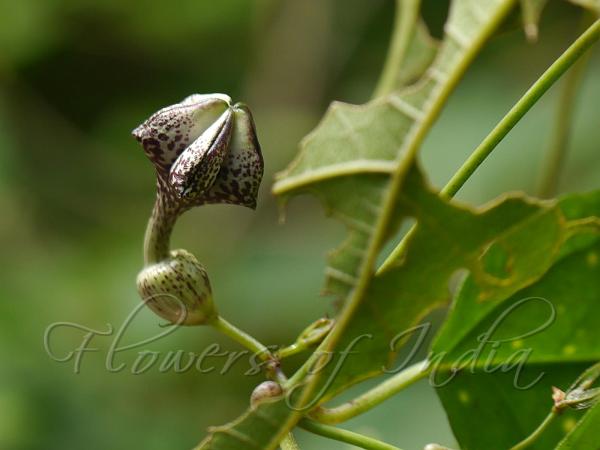|
| Kanara Ceropegia |
|

|

|
|
|
|
Photo: |
Botanical name: Ceropegia gardneri Family: Apocynaceae (Oleander family)
Synonyms: Ceropegia elegans var. gardneri
Synonyms: Ceropegia elegans var. gardneri
Kanara Ceropegia is a perennial climber similar
to
Ceropegia elegans in having fibrous
roots and 1-3 flowered cymes but differs in having linear-lanceshaped
leaves, petals sparsely fringed with hairs at tip, flower tube
throughout purple within, outer corona shorter than inner and having
red pollinia. Stem is about 4 m in length, hairless, branched. Leaves
are simple, opposite - decussate, exstipulate, stalked; leaf-stalk
1-2.5 cm long, chanelled above, fringed with hairs along the margin and
be neath; leaf lamina 3.6-8.7 x 1.0-4.5 cm, gradually decreasing in
size upwards, ovate-lanceshaped, tapering at tip, rounded-pointed at
base, ciliolate along margin and nerves be neath , hairless otherwise.
Inflorescence is a 2-3 - flowered cyme in leaf axils.
Flower-cluster-stalk is about 7 mm long, hairless, terrete; bracts 2-25
cm long, linear-subulate; flower-stalk about 1.4 cm long. Calyx
5-partite, sepals 5-6 x 1 m m, sparsely hairy along the mid - nerve,
hairless otherwise, subulate. Flower 3-4.2 cm long , white, blotched
with purple; flower tube 2-3 cm long , slightly curved, hairless,
dilated at base, cylindrical at middle, funnel shaped at throat,
stripedd with deep purple lines within, ring of downwardly directed
hairs present at the mouth of dialated part of tube; hairs c. 2 m m
long , unicellular conical, colourless to deep purple, flower lobes
about 1.5 cm long , 1.5-2.5 cm across, fused at the tips forming
ellipsoid cage, upper 1/3 rd green with purple margin, white blotched
with purple veins at the middle, sparsely hairy at the tip and at the
inner side, hairs 4 m m long, variously colo ured. Corona biseriate, 4
.5 x 3 .5 cm; outer corona saucer – bowl shaped, 3 x 3 .5 m m, shorter
than the inner corona, with 5 bifid lobes, ciliat e within; inner
corona erect, about 2.5 cm long, connivent, yellow, blotched with
purple at the base, hairless.
Kanara Ceropegia was considered native to Sri Lanka, but it has
recently been found in Karnataka too.
| Identification credit: Dinesh Valke | Photographed along Bisle Ghat, Karnataka. |
• Is this flower misidentified? If yes,